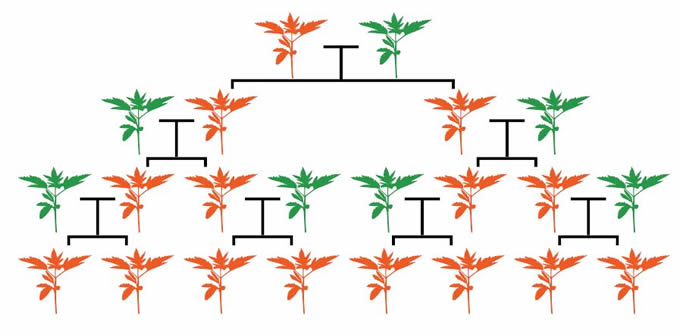Could gene drives be used to control weeds?
New and better methods are needed for managing increasing numbers of unwanted pests worldwide, and the use of genetic modifications involving gene drives is being seriously considered. The idea behind a gene drive is to preferentially increase the frequency of selected genes throughout a target population, in this case genes that would be deleterious to the unwanted pest. Most naturally occurring genetic alterations are only inherited conventionally, and spread is generally linked to fitness advantages in nature, but the use of gene drives could change that.
The potential applications for gene drives has taken a leap forward since the development of a relatively easy genetic splicing technique, called CRISPR/Cas, which has excited scientists all over the world by its potential. In the US, New Zealand and Australia, regulatory authorities have opted to explore this line of research because of its theoretical potential to manage undesirable populations, albeit with extreme caution.
The CRISPR/Cas method enables genes to be automatically inserted into an organism’s, DNA which can then be inherited by all offspring, even if it is present in only one of the parents. For example, genes determining sex expression could, after a number of generations, drive an entire population to be either male or female (or express any other desired genetic trait). The repetition of the gene expression in all progeny of subsequent generations is high because CRISPR/Cas acts as a selfish genetic element, altering the same genes on both paired chromosomes.

The potential of this approach is leading to a wave of research to consider the potential of this technology to control a range of pests. Rapidly reproducing pests, such as insects, are of early interest, because the desired trait can filter down through a population relatively quickly. Researchers at the Wyss Institute at Harvard University are proposing to use the technology to reduce the incidence of insect-borne diseases such as malaria and dengue fever by manipulating the sex ratio of wild populations of mosquitoes. The term they use to describe this field of research is “biologically inspired engineering”. The Gates Foundation is targeting similar approaches in Africa.
The potential for using CRISPR/Cas gene drives to control weeds was raised at the recent XV International Symposium on Biological Control of Weeds by Andy Sheppard from CSIRO (Australia), who has been investigating the benefits that could be generated using the technology. Andy described the gene drive system as “a self-sustaining meiotic genetic mechanism that can propagate modified gene(s) through a target population, circumventing Mendelian inheritance”.
This approach requires understanding the functions of genes and therefore which ones to target. Weeds in agricultural settings are likely to be easier targets initially, since more is known about what genetic elements are responsible for dictating whether offspring plants are male or female. Andy explained that the idea would be to select drives that result in a sexually biased population; for example, by driving the formation of male-only pollen so that female plants become locally extinct.
The term ‘population-suppression drives’ has been coined to describe this line of research. The potential for the technology to be used for weed control would be limited to sexually reproducing weeds. Andy pointed out that the challenge would be to target genes that reduce population fitness without reducing individual fitness. Other applications could include reducing seed persistence or competitive ability, or altering the resistance of weeds to commonly occurring pathogens.
Another avenue of research is to develop ‘population‐sensitising drives’, whereby genes that confer herbicide resistance are silenced, potentially reversing the increasing abundance of herbicide-resistant weed genotypes. Andy suggested that this may be more palatable to the general public or regulators since it targets genes that have already been artificially modified by human activities, returning the populations to ancestral herbicide-susceptible genotypes and allowing weeds to be better managed using approved chemical approaches. A lot of research has already focused on mutations that confer herbicide resistance, which could speed up gene drive development, giving this approach a potential head start. Other possibilities include manipulating the time it takes for seeds to mature so that weeds are not harvested with a crop and inadvertently moved around.
Despite its potential for some agricultural weed species, others would not be suitable candidates. Andy suggested that weeds that reproduce vegetatively could not be targeted, and long-lived perennial weeds with a long-lived seed bank, such as gorse (Ulex europaeus), would also be challenging targets.
Despite its potential, the challenges facing the development of this technology are many. Public acceptability and the ability to manage the risks associated with releasing a self-replicating GM gene-drive system into nature are top of the list. Questions have been raised as to how quickly species in the wild could develop resistance to and nullify the gene-drive system. Other concerns relate to broad-scale implications associated with impacts on ecosystem processes and food webs.
Andy concluded by saying that the public acceptability of GM technologies and associated regulatory systems will need to radically change, and the risks of these new approaches and their management better understood, before any trials would be acceptable in countries like Australia and New Zealand (where GM technologies currently cannot be released). That is unless natural gene drive systems can be adapted. The main recognised research organisations interested in this type of research globally have agreed to an international full disclosure code of practice supported by national regulators, ensuring public awareness and accountability as research to explore the opportunities progresses.
